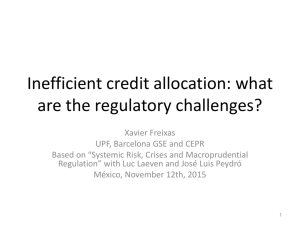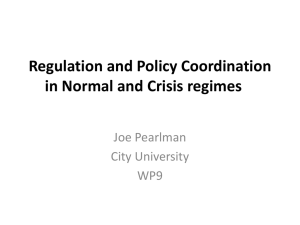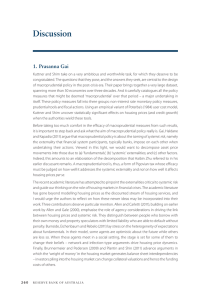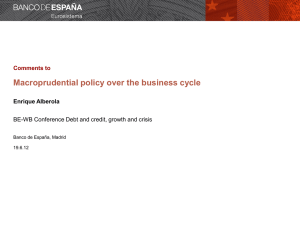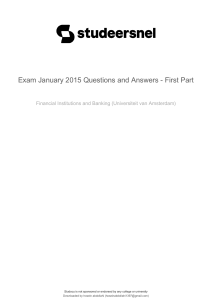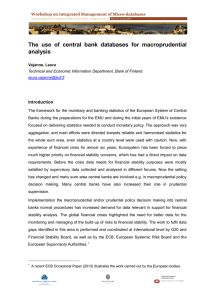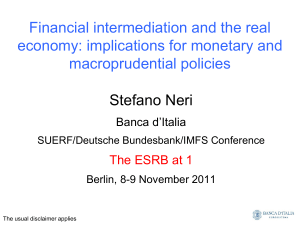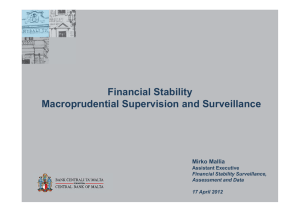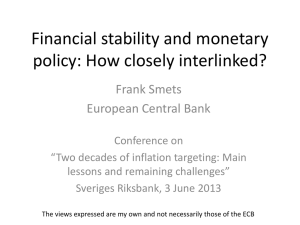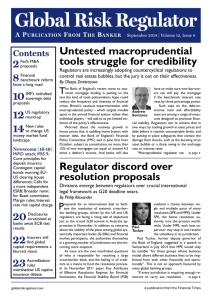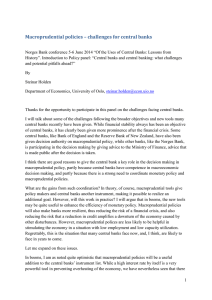The effectiveness of macroprudential tools
advertisement
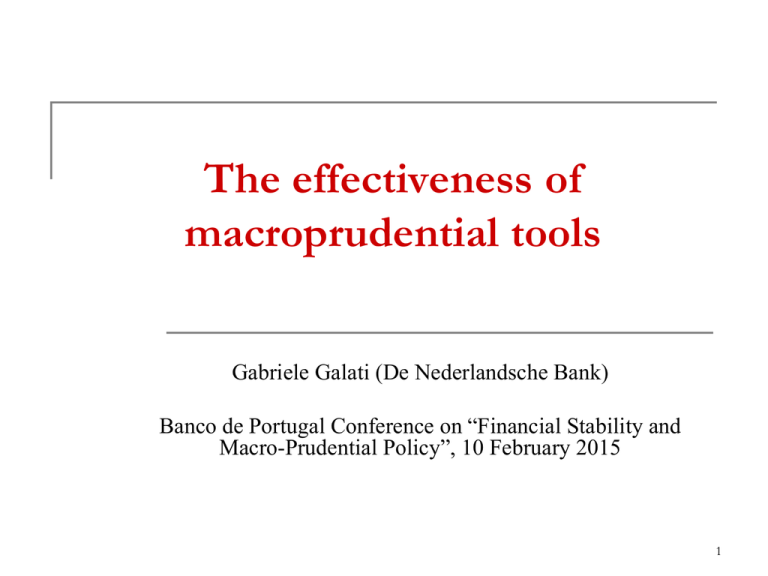
The effectiveness of macroprudential tools Gabriele Galati (De Nederlandsche Bank) Banco de Portugal Conference on “Financial Stability and Macro-Prudential Policy”, 10 February 2015 1 Disclaimer: The views expressed are those of the author and should not be taken to reflect those of DNB or of the Eurosystem. 2 “We are all macroprudentialists now” Growing consensus that a macroprudential approach to regulation and supervision should be adopted. Policymakers around the globe are implementing macroprudential policy tools and frameworks. 3 Macro-prudential policy […] has the objective of safeguarding financial stability, by strengthening the resilience of the financial sector and preventing systemic risk. The effectiveness […] will be assessed by monitoring a set of indicators that signal risk factors and by measuring progress against the intermediate objectives. This assessment will enable […] to assess the adequacy of its intermediate objectives and instruments. (Banco de Portugal Press Release, 29 December 2014.) 4 But what do we know about how macroprudential tools work? From a theoretical point of view, no agreed modeling framework of the interaction financial system - macroeconomy. Empirical evidence on effects of macroprudential tools still scarce, since they are introduced widely only in recent years. Policy ahead of research However, major research efforts over the past few years to fill the gap 5 Compare this to monetary policy… Rich literature and standard workhorse for modelling optimal monetary policy and the monetary transmission mechanism Large body of empirical evidence on transmission channels and effectiveness But since the crisis, less certain about how monetary policy, particularly non-standard, works Both literature strands are at the same crossroads 6 Four approaches to study effectiveness and transmission Analysis of historical experiences Stylized presentations e.g. transmission maps (CGFS, 2012) Theoretical approaches e.g. Haldane, 2011; Elliott, 2013 Banking models, DSGE macro Empirical analysis Alternative identification strategies 7 What have we learned? (I) Advances in methodology Banking models: introduce meaningful role of time and the business cycle to study macroprudential tools that address the procyclicality of the financial system. Use general equilibrium analysis to analyze risk-taking behavior of heterogeneous agents in an economy that is vulnerable to systemic risk and in which default can occur 8 Macro models: beyond linearization, complete markets and no/exogenous default DSGE models with financial-real linkages can explain how these can generate systemic crises - rare events resulting from “credit booms gone wrong” followed by deep and long recessions (Boissay et al., 2013). Infinite-horizon DSGE models with occasionally binding endogenous constraints improve understanding of role of regulation in reducing the incidence of financial crises (e.g. Bianchi and Mendoza, 2010). 9 Empirical methods: different strategies to identify impact on macroeconomic and financial variables, i.e. how to distinguish correlation and causation. Event studies; assessments of authorities/ outside observers; reduced-form regression analysis (cross-country panel regressions); macro stress tests; counterfactual analysis; analysis based on micro data. 10 (II) Insights Macroprudential policy can help reach intermediate targets (credit growth, mortgages) but impact on financial stability hard to quantify. General equilibrium effects important. Pigouvian taxes can address externalities that underpin endogenous systemic risk. State-contingent taxes linked to leverage can play an important role for financial stability by supporting precautionary savings. 11 New regulation will induce banks, savers to endogenously alter their other portfolio choices. “Disturbing interactions” between tools E.g. countercyclical bank regulation might increase cross-sectional risk, while policies that reduce cross-sectional risk reduce procyclicality (Horvath and Wagner, 2013). Leakages – cross-border, between types of financial institutions – can be important. Lack of coordination macroprudential monetary policy can reduce effectiveness. 12 Challenges Tricky to identify effect of macroprudential measures typically not taken in isolation but in combination with other policies. The transmission mechanism is likely to change over time as the result of changes in financial intermediation practices and in the structure of the financial system financial innovation, consolidation in the financial sector and changes in the balance between institution- and market-based credit affect systemic risk over time. 13 The interaction with monetary policy affects the transmission mechanism. Think of non-standard measures aimed at supporting credit supply when banks are facing pressure to raise capital buffers. Governance aspects are important but are hard to model. Need to capture interaction of regulation of different types of financial institutions Think of Basel 3 – Solvency 2 14 Thank you. 15 Additional slides 16 Two waves of historical experiences (1) Restrictions on asset and liability side of banks’ balance sheets in the 1930s and following decades in an effort to support the domestic banking system (Haldane, 2011). Literature suggests many of these tools may have succeeded in their short-term goals Helped limit (specific types of) bank credit … but less obvious that they improved financial stability (e.g. Elliott, 2013). 17 (2) In more recent years, macroprudential tools adopted – mostly in EMEs – to strengthen the resilience of the domestic financial system. Typically two types of measures limit credit supply to specific sectors prone to excessive credit growth (e.g. caps on LTV ratios or debt/income ratios to limit mortgage lending) prevent build-up of imbalances from cross-border capital flows (e.g. via reserve requirements). 18

